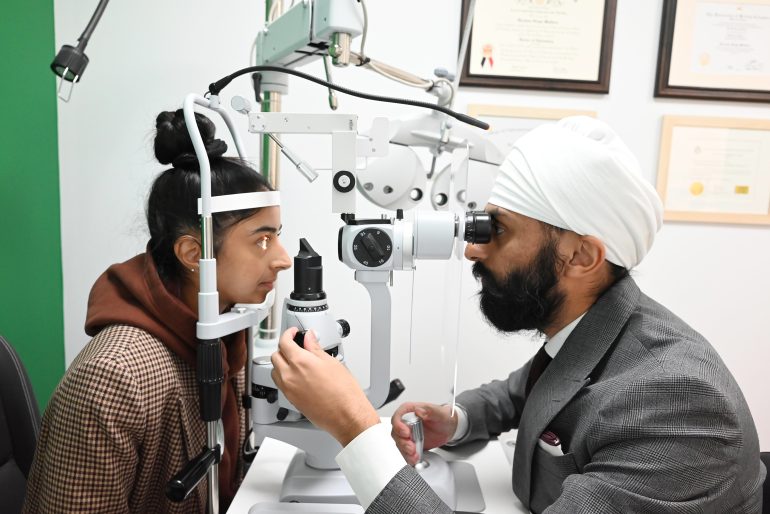BY SURBHI GOGIA
Dr. Darshan Singh Matharu talks about the importance of routine eye exams to save your eyes from permanent damage caused by Glaucoma.
When was your last eye exam? If you are contemplating, this could be a suitable month to arrange an appointment with your eye doctor. Many people are unaware that Glaucoma can steal your eyesight.
Glaucoma affects millions and is one of the leading causes of permanent vision damage globally. In Canada, too, it is one of the leading causes of blindness, affecting more than 450,000 Canadians. Unfortunately, awareness remains limited.
Glaucoma is the name of a group of eye diseases that damage the optic nerve. This nerve connects the eye to the brain and sends images to the brain. Damage caused by Glaucoma to this nerve can lead to vision loss and blindness. The most worrying part about Glaucoma is that it progresses without symptoms or warning signs, gradually worsening eye conditions. If left untreated or improperly managed, it can lead to permanent and irreversible vision loss, ultimately resulting in blindness.
January marks Glaucoma Awareness Month. In observance, Dr. Darshan Singh Matharu, an optometrist and owner of Specsavers in Terra Nova, Richmond, underscores the importance of regular, comprehensive eye examinations as the primary defense against Glaucoma-related blindness.

“Unlike other eye diseases where you have symptoms like headaches, blurred vision or eye pain. A stealthy condition like Glaucoma appears without symptoms. If left undetected and untreated, it leads to permanent, irreversible vision loss. That’s why it’s often called the silent thief of sight,” Dr Matharu says.
Fighting Blindness Canada, a charitable advocate for vision research, reveals that 700,000. Nevertheless, this US-trained optometrist argues that the figure is much higher. “Many individuals who forgo regular eye checkups remain unaware that this condition gradually damages their optic nerve. Regardless of whether you have perfect 20/20 vision or wear prescription glasses, you could be affected,” he emphasizes.
Dr. Matharu says most theories suggest that Glaucoma is caused by pressure on the optic nerve due to fluid accumulation in the front part of the eye. The eye produces a fluid called aqueous humor, which nourishes and maintains its shape. When there is no proper drainage of this fluid, pressure builds up in the eye. Glaucoma typically develops when this increased pressure damages the optic nerve.
However, some people suffer, even with normal eye pressure. He says while it can affect anyone, factors like ethnicity, age, certain medications, and overall eye health also put you in the high-risk category. People with Hispanic or African heritage are disproportionately affected by Glaucoma. “If you have a family history of glaucoma, it is important to get regular eye checkups,” he suggests.
When questioned about the potential risk for individuals with underlying health conditions such as diabetes and high blood pressure, he responds, “While there may not be a direct correlation between glaucoma and other health conditions, it remains crucial to monitor your overall eye health consistently.”
There are different types of Glaucoma. The most common form is chronic Glaucoma, which develops very slowly. A rarer form, called acute Glaucoma, develops abruptly and with sudden elevated and painful pressure in the eye.
Chronic Glaucoma is not usually associated with pain. Since Glaucoma is asymptomatic in the early stages, self-detection is difficult. The condition starts to worsen when the pressure on the optic nerve increases. At this stage, there are no symptoms. It progresses slowly, causing peripheral vision loss that often runs unnoticed because most of us only care about our central vision.”
Acute Glaucoma, on the other hand, is associated with severe eye pain, headaches, nausea, and sudden visual impairment. Other symptoms may include blurred vision and circles of light around light sources. “Unfortunately, by the time symptoms become noticeable, significant damage to the optic nerve may have occurred, making early detection critical for preserving vision,” he says.
“The good news is that early detection can protect your vision from permanent damage or minimize further vision loss. Unfortunately, any vision loss cannot be reversed,” Dr Darshan Singh Matharu says.
Regular comprehensive eye exams play a pivotal role in early detection. Dr. Matharu points out that Specsavers has taken a global lead in early glaucoma detection by installing OCT machines in their locations. OCT is an advanced 3D eye scan included in every Specsavers eye exam.
OCT scans work by taking scans of the back of the eye. These scans form a detailed 3D image of essential structures in your eye, such as the optic nerve, retina, and macula. These 3D scans help optometrists spot abnormalities and identify eye diseases in their early stages,” adds Dr Matharu.
Once detected, there is no definitive cure for this condition. However, the primary line of defense typically involves treatment with eye drops, aiming to manage the condition and curb further vision loss.
He explains further, “If the pressure cannot be effectively controlled with eye drops, laser treatment is an option to improve eye drainage. However, this is typically considered in more advanced stages.”
Treatment varies based on coverage. Several brands are available, and you can discuss options with your doctor to choose one that aligns with your budget.
Dr Matharu says knowledge is the most potent weapon against Glaucoma. Understanding the risk factors, recognizing the subtle symptoms, and embracing regular eye examinations are critical components in the battle against this silent thief of sight.






